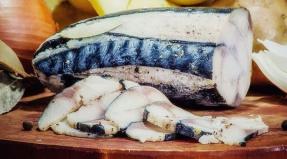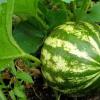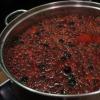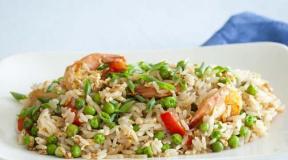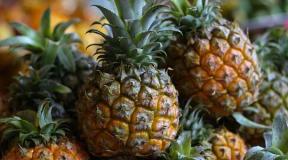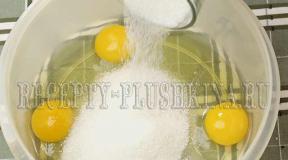Ground dried paprika. Dried peppers: methods and recipes for cooking at home
Dried paprika: what are the useful components of the spice, can the seasoning be harmful. Recipes for dishes that spice complements especially harmoniously.
The content of the article:
Dried paprika is a spice, which is the dried and ground fruits of the capsicum capsicum annuum. South America gave us a fragrant spice of bright red color with a sweetish and moderately pungent taste. In Europe, the seasoning appeared thanks to the travels of Columbus. The famous navigator called it "Indian red salt". Today paprika is cultivated in Hungary, Spain, Turkey and the USA. Seven varieties of spices are produced, the main characteristic of each of which is the degree of pungency. The pungency is regulated by the peculiarities of the production process. The fruit of the pepper is first dried, then the core and grains are carefully removed from it and only after that they are ground. If the manufacturer wants to make the seasoning spicier, some of the seeds are not removed. The more grains remain in the fruit, the sharper the spice will turn out.
Calorie content and composition of dried paprika

Paprika is valuable not only for its interesting taste and rich aroma, but also for the unique composition of the most useful biologically active substances.
The calorie content of dried paprika is 282 kcal per 100 g of product, of which:
- Proteins - 14.14 g;
- Fat - 12.89 g;
- Carbohydrates - 53.99 g;
- Dietary fiber - 34.9 g;
- Water - 11.24 g;
- Ash - 7.74 g.
- Potassium - 2280 mg;
- Calcium - 229 mg;
- Magnesium - 178 mg
- Sodium - 68 mg;
- Phosphorus - 314 mg
- Iron - 21.14 mg;
- Manganese - 1.59 mg;
- Copper - 713 mcg;
- Selenium - 6.3 mcg;
- Zinc - 4.33 mg.
- Vitamin A, RE - 2463 mcg;
- Alpha carotene - 595 mcg;
- Beta carotene - 26.162 mg;
- Beta cryptoxanthin - 6186 mcg;
- Lutein + Zeaxanthin - 18944 mcg;
- Vitamin B1 - 0.33 mg;
- Vitamin B2 - 1.23 mg;
- Vitamin B4 - 51.5 mg;
- Vitamin B5 - 2.51 mg;
- Vitamin B6 - 2.141 mg;
- Vitamin B9 - 49 mcg;
- Vitamin C - 0.9 mg;
- Vitamin E - 29.1 mg;
- Vitamin K - 80.3 mcg;
- Vitamin PP, NE - 10.06 mg;
- Betaine - 7.1 mg
- Arginine - 0.89 g;
- Valine - 0.75 g;
- Histidine - 0.25 g;
- Isoleucine - 0.57 g;
- Leucine - 0.92 g;
- Lysine - 0.69 g;
- Methionine - 0.2 g;
- Threonine - 0.49 g;
- Tryptophan - 0.07 g;
- Phenylalanine - 0.61 g.
- Omega-3 - 0.453 g;
- Omega-6 - 7.314 g;
- Saturated - 2.14 g;
- Monounsaturated - 1.695 g;
- Polyunsaturated - 7.766 g;
Useful properties of dried paprika

The beneficial effect of the spice on the body is fully revealed with the constant use of the spice in food. The seasoning contains many biologically active substances that have a positive effect on the functioning of all systems, tissues and organs. It is important to note that paprika made from sweet peppers is completely safe when added to dishes even in a sufficiently large amount, which cannot be said about hot ground pepper, the amount of consumption of which must be monitored in order to avoid inflammation of the mucous membranes.
Let's consider the benefits of dried paprika in more detail. On the list of beneficial effects of the spice:
- Boosting the immune system... The spice contains a large amount of carotene and vitamin C, as well as other "immune" components. This fact makes the spice surprisingly useful in increasing the body's resistance to certain diseases.
- Positive effect on the circulatory system... Paprika thins and cleans the blood from excess cholesterol, prevents the formation of blood clots, which in turn is an essential element in the prevention of acute cardiac conditions.
- Strengthening the cardiovascular system... The spice has a general strengthening effect on blood vessels and heart muscle.
- Regulation of the digestive system... The spice prevents the development of diseases of the gastrointestinal tract and allows you to fight its disorders. It is especially effective for cramps, flatulence.
- Acceleration of metabolic processes... Paprika normalizes metabolic processes in the body, for which it is especially loved in dietetics. Spice contributes not only to faster, but also more efficient absorption of nutrients. Thus, any dish flavored with spices becomes not only tastier, but also healthier.
- Stimulation of potency... Due to its tonic effect, the spice is used as an aphrodisiac. Paprika stimulates sexual desire, not only in men, but also in women.
- Improving hair condition and strengthening nails... The content of a large number of micro and macro elements in the spice helps to improve the condition of nails and hair. The spice is recommended for the prevention of early hair loss.
- Prevention of visual impairment... Paprika contains a lot of lutein, which makes it especially beneficial for the eyes. The spice keeps the retina healthy, even if a person has to work a lot at the computer or strain their eyes for another reason.
- Positive effects on the nervous system... The use of dishes with the addition of spices improves mood, gives energy and strength, and has a beneficial effect on memory and sleep. Doctors say that the spice even helps fight depression.
- Strengthening joints and muscles... The spice belongs to the warming spices, and therefore it is able to relieve joint pain and is a good means of preventing arthritis, arthrosis, rheumatism.
Harm and contraindications to dried paprika

Unfortunately, not everyone can appreciate the beneficial effects of paprika on their body. This spice contains a lot of useful components, but, nevertheless, in view of some features of the composition, it is contraindicated for some people. Let's find out who paprika can harm:
- Hypertensive patients... The spice thins the blood, and therefore it is contraindicated for people with high blood pressure.
- Patients suffering from serious diseases of the digestive system... Despite the fact that paprika has a useful property to fight gastrointestinal disorders of one nature or another, its use in severe diseases of the digestive system is contraindicated.
- People with increased CNS excitability... Individuals with an unstable nervous system should be cautious in using the spice - the tonic properties of the spice can play a cruel joke.
Do not forget that the spice can cause allergies due to individual intolerance to the components. In this case, the use of spices in food is also not allowed.
Dried paprika recipes

The use of dried paprika in recipes makes the taste of dishes more interesting and their aroma richer. This fact helped the spice to make a successful "career" in the culinary world. Spice is especially loved in Hungary. In this country, it is actively cultivated and is added to literally all dishes, and Hungarian paprika is already a national brand. The average Hungarian, according to statistics, eats half a kilogram (!) Of spices a year. The main national dish of Hungary, called paprikash, speaks for itself.
They are also very fond of the spice in Spain, Germany, Mexico. The seasoning is added mainly to meat, it goes especially well with chicken and pork. The spice is also used in soups and vegetable salads. It is also part of the world famous barbecue sauce with a delicious taste and unsurpassed aroma.
What dishes does paprika make especially tasty? Here is a list of some of them:
- ... Cut chicken breast (2 pieces) into portions, fry in a pan for 10-15 minutes in olive or vegetable oil. Remove the meat from the pan; the vegetables will now be stewing in it. Chop onions (3 heads), fry them until transparent. Cut the bell peppers into large cubes (4 pieces), if you want the dish to turn out especially colorful and appetizing, use fruits of different colors. Add the peppers to the onions and continue to cook the vegetables together for 3-5 minutes. Add flour (2 tablespoons) and paprika (2 tablespoons), stir well and cook for another 2-3 minutes. Chop tomatoes (2 pieces) and apples (2 pieces), preferably sour varieties. Add the tomatoes and apples to the skillet and simmer for another 5 minutes. Pour sour cream (150 ml) into the pan, salt and pepper, return the chicken breast. Stir everything thoroughly and simmer for another 2-3 minutes. Paprikash is served with herbs, best of all with parsley.
- Barbecue sauce... Mix sugar (250 grams), preferably brown, in the absence of - ordinary white, mustard powder (1 tablespoon), red wine vinegar (100 ml), tomato paste (300 ml), soy sauce (1 tablespoon), paprika (2 tablespoons), black pepper (0.5 teaspoon), salt (1 teaspoon). Mix the ingredients thoroughly, heat, stirring, until the sugar is completely dissolved. The sauce is ready, you can eat it warm and cold.
- Crab Meat Corn Soup... Chop the onion (1 small onion), grate the carrots (1 piece) and pass in olive or vegetable oil for 5 minutes. Add canned corn (2 large cans), simmer for 5 minutes. Bring milk (1 liter) to a boil, add vegetables to it and cook for 15-20 minutes. Add spices - paprika and ginger to taste, salt, turn off the heat. When the soup has cooled slightly, beat it with a blender, strain to remove the corn husks. Add 1 pack of coarsely grated crab meat and serve the soup, garnished with sesame seeds.
- Bulgur salad... Boil bulgur (200 grams), remove the skin from the tomatoes (2 pieces), scald them with boiling water. Chop green onions (1 bunch), tomatoes, parsley (1 bunch) and mint (1 bunch). Mix all prepared foods with bulgur, add olive oil (2 tablespoons) - can be replaced with vegetable oil, tomato paste (30 grams), paprika (1 teaspoon), salt and pepper to taste, sprinkle with lemon juice. The salad can be eaten both warm and cold.
- Tomato pie... Beat eggs (3 pieces) with milk (200 ml), add tomato paste (60 grams), paprika (1 teaspoon), sugar (2 teaspoons). Sift flour (250 grams), add it to the rest of the ingredients, salt. Add ham (100 grams), olives (15-20 pieces), grated cheese (100 grams) to the dough. Bake the pie for an hour at 180 degrees. It is best eaten chilled.
- Mackerel by Gordon Ramsay... Prepare the fish (2 pieces): peel, remove the head, remove the entrails and cut in half lengthwise. Combine olive oil or vegetable oil (2 tablespoons), minced garlic (3 cloves), paprika (1 teaspoon). Salt the fish and brush generously with the marinade. Wrap the mackerel in foil and place in an oven preheated to 180 degrees for 20 minutes.

Continuing the story about the love of Hungarians for spices, it is worth mentioning that in the Hungarian city of Kalocha there is a spice museum, where you can learn its history, peculiarities of cultivation and production.
At the same time, it is curious that initially the seasoning was not appreciated in Hungary. The Turks brought it to the country in the 17th century. When the latter left the Hungarian lands, the attitude towards the spice changed dramatically.
In Columbus's time, paprika was considered a fairly affordable spice: it was often replaced by black pepper, which only rich people could afford.
Handmade paprika is more appreciated, although machine-made spice looks more aesthetically pleasing. A special machine allows you to get a more homogeneous powder, but it destroys some of the useful components.
The spice is actively used in dietetics. The spice is a component of anti-obesity patches, various body shaping creams and anti-cellulite products.
Paprika is used as a natural colorant in the production of meat products, in particular sausages. The spice not only improves the appearance of the product, but also makes it more aromatic and appetizing.
Ground spice contains sugar, and therefore, when frying it without enough liquid, it can burn and become caramelized.
Watch a video about Capsicum annuum pepper:
Dried paprika is a spice that can make any dish more appetizing and healthier. Seasoning can add an original touch even to the most commonplace dishes, for example, omelet or mashed potatoes. However, to fully appreciate the “culinary power” of the seasoning, prepare one of the signature spice recipes - for example, Hungarian paprikash.
The bright taste of ground paprika is used to create various dishes, especially if they are soups or main dishes from vegetables! Ground paprika is an excellent substitute for tomato paste and adds to the cooked food a subtle aroma of bell pepper, a reddish tint and a little oily, since the seasoning itself is a little oily.
Cooking ground paprika is difficult - it takes time and patience. From 1-1.2 kg of red bell pepper of the "Paprika" variety, about 50-80 g of bright red seasoning is obtained.
Recipe Information
Cooking method: drying.
Total cooking time: 4-5 h
Servings: 10 .
Ingredients:

- red bell pepper "Paprika" - 1-1.2 kg.
Cooking method
 Rinse the peppers in water and cut off the top caps from each vegetable, taking out the seeds next. Rinse the inside thoroughly and pat dry with a towel - you don't need extra moisture when drying!
Rinse the peppers in water and cut off the top caps from each vegetable, taking out the seeds next. Rinse the inside thoroughly and pat dry with a towel - you don't need extra moisture when drying! Cut each pepper into cubes as small as possible, but do not pass through a meat grinder, otherwise you will have a lot of juice and it will be difficult to dry the paprika!
Cut each pepper into cubes as small as possible, but do not pass through a meat grinder, otherwise you will have a lot of juice and it will be difficult to dry the paprika! Line a baking sheet with parchment paper and place all the peppercorns on top of it. If you cut a lot of pepper, then try to dry it in two stages, and not lay out a dense layer at a time - it will not dry out, but burn, and all the work will go down the drain! Put the baking sheet in the oven at 10C for 1-1.5 hours and in the middle of drying, stir the contents of the baking sheet once so that it dries better.
Line a baking sheet with parchment paper and place all the peppercorns on top of it. If you cut a lot of pepper, then try to dry it in two stages, and not lay out a dense layer at a time - it will not dry out, but burn, and all the work will go down the drain! Put the baking sheet in the oven at 10C for 1-1.5 hours and in the middle of drying, stir the contents of the baking sheet once so that it dries better. After the indicated time, remove the baking sheet and let the pepper pieces dry at room temperature for about 1 hour. They don't have to be dry - don't worry! The pepper itself is very oily, so it is dried in several stages.
After the indicated time, remove the baking sheet and let the pepper pieces dry at room temperature for about 1 hour. They don't have to be dry - don't worry! The pepper itself is very oily, so it is dried in several stages. Once 1 hour has passed, add the pepper chunks to a blender or food processor container.
Once 1 hour has passed, add the pepper chunks to a blender or food processor container. Grind. The powder will not work, since the resulting seasoning must be dried in the oven again - pour it out of the container onto a sheet of paper and put it back in the oven for 30 minutes at 100C. Do not forget to open the appliance door every time you dry.
Grind. The powder will not work, since the resulting seasoning must be dried in the oven again - pour it out of the container onto a sheet of paper and put it back in the oven for 30 minutes at 100C. Do not forget to open the appliance door every time you dry. Pour the hot dried seasoning back into the blender container and chop again.
Pour the hot dried seasoning back into the blender container and chop again. Now the desired result will be achieved - the seasoning will turn into a popular culinary powder.
Now the desired result will be achieved - the seasoning will turn into a popular culinary powder. Ground paprika has a velvety texture and a bright red color, and even an excellent aroma!
Ground paprika has a velvety texture and a bright red color, and even an excellent aroma!- Store it in a container that closes or curls tightly to prevent the seasoning from picking up moisture. Take out as needed and cook as needed - now you know how to do it!

Dried paprika has long been a popular seasoning for many dishes. It easily gives not only expressiveness to the taste of dishes, but also a beautiful orange color to broths, soups and sauces. This spice is found in many versatile blends to enhance the flavor of ready-to-eat meals.
Let's figure it out together what kind of product it is with the interesting name "paprika". All culinary specialists know that it can be bought almost everywhere: this spice is found in large quantities on the shelves of supermarkets and shops, and many manufacturers produce it. In addition, they all adhere to a certain GOST, because it is impossible to come up with anything new in drying sweet peppers. But in fact, there are many nuances in choosing a quality product. But how to make the right choice, we will tell everyone in this article.
Types of paprika
There are many types of paprika. For the most part, housewives will answer that paprika on sale can be ground and in pieces, as well as red and green, and the latter characteristic directly depends on the color of the raw material. Some more experienced housewives will note the presence of smoked paprika. In fact, the product has many more differences. They will be discussed in the table below:
The paprika produced in Hungary is considered the most piquant and fragrant, but the most delicate is usually the product produced by the industry in America and Spain.

The chemical composition of the spice
The chemical composition of the spice is fully consistent with the composition of sweet pepper, only more high-calorie, because moisture is completely removed from the product. But the use of paprika in cooking is limited to a teaspoon, so the product in no way can harm the figure. A level teaspoon of seasoning contains about the same amount of minerals and trace elements as in one hundred grams of fresh bell pepper.
The product perfectly retains:
The dried product contains small amounts of capsaicin, which is responsible for the taste of the seasoning, as well as essential oils that allow the product to recreate the aroma of fresh pepper when it gets into water.

Application of paprika
The use of paprika in cooking has become widespread due to its amazing taste. Initially, the use of paprika was noted in Asian and Eastern cuisines, but now the spice is also used by Europeans. The finished product can be purchased both by weight and packaged in bags with a minimum weight of 10 grams.
Due to the fact that this product is widely used in various mixtures for preparing meat dishes, many housewives will be interested in what spices this aromatic seasoning is combined with. I would like to note that the most advantageous product manifests itself with:
- basil;
- coriander;
- garlic;
- bay leaf;
- chili;
- thyme.
Dried peppers are used in the manufacture of various marinades for meat and dressings with tomatoes or tomato paste in the composition, as well as when cooking soups and stewing vegetable stews. The latter is especially convenient in the winter season, when there is no opportunity to purchase high-quality ground pepper.

Paprika, dried in pieces, is used in canning, it does an excellent job with the functions of sweet pepper. It is used in the preparation of paprikash, goulash and homemade sausages. The seasoning can be called universal, because it goes well with:
- chicken;
- duck meat;
- eggs;
- pork;
- beef;
- beans;
- various cheeses;
- most seafood.
To get the most out of the product, you should remember these rules:
- Never fry it, because this makes it bitter and the dish with it begins to burn quickly.
- Do not cook ground paprika for more than two minutes, and dried paprika in pieces for more than five minutes, because exceeding the cooking time will negatively affect its taste.
Meat for barbecue and kebabs, marinated with paprika, acquires a surprisingly mild aftertaste and delicate aroma, and soups and broths, in addition to taste, acquire a golden color.
I would like to note that, despite the versatility of dried paprika, there are components incompatible with it that can completely drown out the natural qualities of the product. These foods themselves are very savory, and they are onions and cilantro.

Benefit and harm
The benefits that the use of paprika brings in the diet can be called the ability of the seasoning to optimize digestion, and the consequence of this will be that the human body will be able to more fully assimilate the nutrients from the accompanying food components. Paprika, which is regularly found in food, helps a person cope with such disorders of the gastrointestinal tract and their unpleasant manifestations, such as:
- flatulence;
- cramping;
- stomach cramps;
- excessive gassing.
The presence of spices in food improves the functioning of the cardiovascular system, increases blood flow and prevents the formation of blood clots. Only now its use in this case should be regular.
The use of paprika along with other spices is indicated for overweight, because this product has a positive effect on metabolism and all endocrine glands. The best way to consume the product in this case is to mix it with any vegetable oil and season with this mixture of vegetable salads.
Paprika also has a positive effect on the immune system, so it can be used for medicinal purposes, adding in small portions to anti-cold tea.
Nutritionists do not recommend the use of paprika for people who have an individual intolerance to the product, as well as for those who suffer from liver and kidney disease, which is especially important in the stage of exacerbation of the disease. It is also necessary to limit the amount or temporarily stop using the seasoning for those who are susceptible to attacks of pancreatitis, chronic stomach ulcers, and angina pectoris, in order to avoid the negative manifestations of these diseases.

Home cooking
Cooking paprika at home is welcomed by many housewives who appreciate the naturalness of the products. There is nothing complicated in this matter. All the chefs need is a little patience. I would like to note that it is easiest to prepare dried paprika in a convection oven or in an electric dryer, but in the absence of them, you can also use a regular oven.
Experienced housewives advise to dry the pepper in a shaded, but rather hot room before drying. In a private house, it can be a summer kitchen or a gazebo, and in a city, a balcony will help solve the problem. It is not recommended to prepare bell peppers directly in the apartment due to the strong smell of the original product.
To obtain aromatic paprika, it is best to select fleshy fruits of red or green color at the stage of technical ripeness. Although the fruits of yellow peppers are tender and fleshy, they often have a less pronounced aroma.
To prepare for drying, you will need a thick needle and thick thread. String the washed and dried peppers onto a string, piercing the fruit right through the flesh at the base of the stalk, and then hang it up for about five days. The peppers should be spaced far apart. When the pepper wrinkles a little, then remove the stalks and testes from it along with the seeds, peel off the dense skin, and then cut the product into slices or strips of your choice. Keep in mind that the weight of the finished paprika will be about ten times less than the original weight of the prepared pepper!
Dry the paprika at 55 degrees Celsius in an oven or electric dryer for six hours. To avoid sticking to the baking sheet or sticking to the wire rack, spread the raw peppers on parchment paper.
Cool the finished product to room temperature, and then pour it into a tightly closed jar or paper bag and store in a dry room with a constant temperature. Most culinary experts believe that the seasoning prepared in pieces has the maximum aroma and piquancy, and therefore prefers this type of product.
If you want to get homemade paprika in powder, then grind the dried pepper in a mortar or spin it in a special mill designed for grinding seasonings, after passing it through a meat grinder with a fine grid. The resulting mass should be calcined at a temperature of 100 degrees Celsius, and then cooled to room temperature. Only in this case the product will turn out to be loose and pleasant to the touch and retain its aroma.
The use of homemade paprika for food does not differ from the use of a store analogue, only the shelf life of such a product is shorter due to the naturalness of the components and the absence of various additives from caking and clumping. But this is precisely where the beauty of a genuine product lies!
Scientists have long noted the fact that people who regularly use paprika in their diet look younger and are in good health. What we wish for you too!

Then pamper yourself with a jerky delicacy.
You will need to pick up good grade, prepare the pepper for drying, and set the desired mode. Such peppers can be stored for almost the entire cold season in several ways.
Benefit
What are the benefits of dried peppers?
Dried sweet peppers keep almost all vitamins and minerals participating in the development of the body, maintaining reliable immunity and protecting against vitamin deficiency.
This is possible thanks to the complex of vitamins A, group B, C, E and PP, as well as phosphorus, potassium, calcium, magnesium, manganese, sodium and iron.
Regular use dried pepper activates the digestive system, strengthens hair and nails, improves vision.
Useful material contained in sweet pepper, normalize the work of the cardiovascular system, reduce the risk of blood clots, thinning the blood, and strengthen the walls of blood vessels.
Also, pepper brings invaluable benefits to the condition of the skin and mucous membranes.
Energy value and calorie content Dried peppers: There are approximately 118 calories per 100 grams of dried bell peppers.
Vegetable preparation
How to prepare peppers for drying? First, choose the appropriate bell peppers. They should be sweet taste, with a bright red or yellow color. Make sure the vegetables not overripe, there are no wrinkles and spots on the skin. In terms of thickness, you need a juicy, fleshy pepper, with a dense layer of pulp inside.
After the vegetables have been thoroughly washed, leave them to dry slightly on a paper towel. Large vegetables are cut into quarters and medium sized vegetables are cut into halves. Thin films and seed box carefully cut out.
In some cases, it is advised to cook skinless, which will make the taste more intense and delicate.
The pepper will peel easily if Keep it in boiling water for 2-3 minutes and the same amount of time to cool in the cold. Using a knife, you can gently pick up the skin and easily peel off the pepper.
Before you start drying, you can either grease the pepper or leave it without oil at all. Will fit as usual sunflower and olive... To enhance or add a unique flavor to the pepper, use different spices... Sprinkle the slices with salt, black pepper, or red pepper. You can also add marjoram or dried basil to taste. About what you can learn from our article.
Just about any blend of aromatic herbs for cooking can make a dried pepper recipe. unique... If you sprinkle a small amount of pepper Sahara, from this it will become even sweeter and more piquant. Thin slices of chopped garlic can be placed in the notches of the pepper to add sharpness.
Choice of technique
 How to cook dried peppers at home for the winter? Various types of household appliances can be used, one of which is oven.
How to cook dried peppers at home for the winter? Various types of household appliances can be used, one of which is oven.
Better to use electric oven as it heats up faster and more evenly. An oven and electric dryer.
At what temperature should pepper be dried? Dry pepper optimally at maximum moderate temperature, which depends on the power of your technique.
On average, the temperature should be set first at 75-80 degrees, then, after one and a half to three hours, increase to 100 degrees... After that, the pepper is briefly pulled out on a baking sheet or wire rack for cooling (for 20-30 minutes), and returned back to the oven for additional 40 minutes or an hour.
How to determine readiness? In appearance, the pepper is slightly darkens, a mesh will appear wrinkles on the skin, and the pulp is about one third will become thinner.
The slices will turn out to be dried, elastic to the touch, but not too hard. If you overexposed pepper, it will be excessively dry and brittle, and almost all the moisture will evaporate.
If the pepper has not yet gained flexibility and has not lost enough mass, leave it to cook for a while. for 20-30 minutes in the oven.
The ways
How to make jerky peppers in the oven? At the lowest heat, if there is such a function, set the mode "Convection" or ventilation... It is necessary that the air circulates freely inside, and the excess moisture is unhindered. evaporated... A slightly open oven door is fine for this, and condensation will not accumulate inside.
It is laid out on a baking sheet parchment paper, which can be soaked in oil if desired. The peppers are placed with their peel down, forming small "boats" so that the seasonings remain inside.
 WITH ajar door pepper is dried for an hour and a half, cools briefly, then warms up again in the oven for 40 minutes.
WITH ajar door pepper is dried for an hour and a half, cools briefly, then warms up again in the oven for 40 minutes.
Do not immediately remove the pepper from the oven - leave it inside for a while. It is better to preserve dried peppers when it is completely cooled down.
How to cook dried peppers in an electric dryer? The sliced pepper is laid out in one layer on a special grid or wire rack, so that there is little space.
The product must not be allowed stuck together or burnt- once in half an hour you need to stir and turn the slices. Desired temperature during cooking - 75 degrees... With active airflow and careful supervision, the pepper will be ready after 3-4 hours.
How to make jerky bell peppers for the winter in the microwave? Microwaving peppercorns is a difficult process.
A vegetable needs access to fresh air so that the pepper does not boil in its own juice, but is systematically deprived excess moisture.
First, the pepper is washed, cut into slices and cleaned of seeds and thin partitions. Sprinkle a little over the pepper oils and put in a deep bowl, put in the microwave.
You can cook on maximum power in several runs for five minutes. After the first five minutes, the pepper is removed, and excess juice merges into a separate bowl.
Give the pepper some cool off, then repeat the process a few more times, bringing the product to full readiness. Don't forget to pour out any juice that comes out.
Recipes
How to cook jerky peppers at home? The most common cooking option is dried peppers in oil for the winter.
Dried peppers for the winter recipe: it is prepared as with the standard scheme, but each piece of pepper is generously greased with olive or sunflower oil.
Bell peppers sun-dried in oil - photo:
Watch a video recipe for drying peppers and tomatoes:
Storage of the finished product
How to store dried peppers for the winter? Pepper can be stored in the same oil in which it was cooked, which will allow keep all the rich taste dishes. In a small sterilized glass jar the dried pepper slices are tightly folded and completely poured vegetable oil(sunflower or olive).
Make sure the oil 2-3 cm exceeds the level of tamped peppers to block access to air.
The resulting banks should be kept in fridge and use as needed. The resulting dried product is simply irreplaceable in the preparation of salads or pizza, can be used ready-made, and also used as a decoration for meat and fish dishes.
 Dried peppers are a good snack on their own.
Dried peppers are a good snack on their own.
Competently cooked dried peppers will be the guarantor tasty and healthy food, which is especially important during the spread of viral diseases.
Pepper will be stored in the refrigerator a little longer if you add a tablespoon to the top of the jar with oil vinegar.
Read also ...
- Recipes for making coffee with ice cream at home
- Strawberry panna cotta - a classic of world culinary What is panna cotta with strawberries
- Cream of curd cheese for cake - the best recipes for impregnating and decorating dessert
- Profiterole recipe and three original custard recipes Protein cream for profiteroles


